Schedule
Garlic Crop Schedule
| Product Name | Fertilizers | |||||
|---|---|---|---|---|---|---|
| Poornima Kit | NPK Grow Caps |
Humigrow Nano Powder |
Alp | Sonha-Bihan | ||
| Humic Acid | Chelated Multi-micronutrient |
PGP/PGR | ||||
| Soil Treatment | week -1 | |||||
| Sowing | week 0 | |||||
| Germination | week 1 | 1 Kit | ||||
| week 2 | ||||||
| week 3 | ||||||
| week 4 | ||||||
| week 5 | ||||||
| week 6 | 2 Caps | 120 gm | ||||
| week 7 | ||||||
| week 8 | ||||||
| week 9 | 250gm | 250gm | ||||
| week 10 | ||||||
| week 11 | 2 Caps | 120 gm | ||||
| week 12 | ||||||
| week 13 | ||||||
| week 14 | ||||||
| week 15 | ||||||
| week 16 | ||||||
| Harvesting | ||||||
| Total Quantity | 1 Kit | 4 Caps | 240gm | 250gm | 250gm | |
| Broadcast | |
| Top Dressing | |
| Basal Dressing | |
| Soil Application | |
| Spray | |
| * | Optional |
NOTE: For the first year donot immidietaly substitute 100% chemical fertilizer with the SIESTO GREEN products, as the soil is used to chemical fertilizer, it may affect the output. So the best way to substitute is by reducing 50% of chemical input in the first year, 25% the following 2nd year, & then another 10% by the 3rd year. After the 3rd year use synthetic fertilizer / inorganic fertilizer if their is a requirement depending on the soil health.
CROP SCHEDULE FOR CABBAGE
RECOMMENDED
Sr. No. Treatment / Application Product Dose /Acre APPLICATION Management 1 Vegetative – Dissolve in 20 to 200 ltr. of water as required for 1 acre of land and apply through Drip Irrigation or drench. POORNIMA KIT 1 KIT Apply it in week 1 that is after transplantation It is a balanced form of nutrients that includes NPK, Zinc, Cropforce NP, Humigrow NP, and Mycorrhiza NP 2 Vegetative – Mix all with the required amount of water and apply through drip irrigation, flood irrigation, or drenching as per farmer’s availability. NPK Grow + Humigrow 2caps + 120gm Apply it in Week 6 It is a balanced form of Nutrition that includes NPK with HumicOPTIONAL
Sr. No. Treatment / Application Product Dose /Acre APPLICATION 1 Soil Treatment – Dissolve in 20lit. to 200lit. of water as per requirement for 1 acre of land and apply through drip irrigation or drench. IBP KIT 1 kit It prevents soil-born diseases and nematodes. 2 Transplantation – Before transplanting basal it. PROM / Organic fertilizer 50 kg/acre Apply It during transplanting as per soil health, weather conditions, and plant needs. 3 Vegetative – Dissolve in 20 to 200 ltr. of water as required for 1 acre of land and apply through Drip Irrigation or drench. POORNIMA KIT 1 KIT Apply it in week 11 or as per requirement. 4 Bulbing – Mix it with ALP and apply through Drip irrigation or Drench near the plants. ALP + Sonhabihan 250gm + 250gm Apply it in week 7 with ALP or as per requirement.PEST ATTACKS, BACTERIAL, OR FUNGAL MANAGEMENT
PEST / BACTERIAL / FUNGAL
IDENTIFICATION IN CROP
SYMPTOMS
SUGGESTED PRODUCT
Thrips
 Both adult and larval thrips feed within the mesophyll layer using a punch-and-suck motion.
Lifeline + Traps + Meta + BT
Mite
Both adult and larval thrips feed within the mesophyll layer using a punch-and-suck motion.
Lifeline + Traps + Meta + BT
Mite
 Adults and nymphs feed primarily on the undersides of the leaves. The upper surface of the leaves becomes stippled with little dots that are the feeding punctures.
Lifeline + Traps + Meta + BT
Cutworm
Adults and nymphs feed primarily on the undersides of the leaves. The upper surface of the leaves becomes stippled with little dots that are the feeding punctures.
Lifeline + Traps + Meta + BT
Cutworm
 Missing, cut, or wilted plants Holes or cavities in leaves, fruits, or roots.
BT + Meta
Downy Mildew
Missing, cut, or wilted plants Holes or cavities in leaves, fruits, or roots.
BT + Meta
Downy Mildew
 Leaves turn pale green. On leaves, cottony white mycelial growth develops and appears white. Gradually the leaves turn pale yellow to dark brown and dry up.
Life-line + Indofa + BT + Bacillus
Fusarium Wilt
Leaves turn pale green. On leaves, cottony white mycelial growth develops and appears white. Gradually the leaves turn pale yellow to dark brown and dry up.
Life-line + Indofa + BT + Bacillus
Fusarium Wilt
 Initially yellowing of leaves and stunted growth of the plant is observed, which later on dry from tip to downwards.
Indofa + BT + Lifeline
Damping Off
Initially yellowing of leaves and stunted growth of the plant is observed, which later on dry from tip to downwards.
Indofa + BT + Lifeline
Damping Off
 Pre-emergence damping-off:This results in seed and seedling rot before they emerge out of the soil.Post-emergence damping-off:The pathogen attacks the collar region of seedlings on the surface of the soil.
Indofa + Bacillus
Purple Blotch
Pre-emergence damping-off:This results in seed and seedling rot before they emerge out of the soil.Post-emergence damping-off:The pathogen attacks the collar region of seedlings on the surface of the soil.
Indofa + Bacillus
Purple Blotch
 The symptoms occur on leaves and flower stalks as small, sunken, whitish flecks with purple-colored centers.
Indofa + Bacillus
Leaf Blight
The symptoms occur on leaves and flower stalks as small, sunken, whitish flecks with purple-colored centers.
Indofa + Bacillus
Leaf Blight
 Infection occurs on radial leaves of transplanted seedlings at the 3- 4 leaf stage during late March and early April.
Indofa + Bacillus
Anthracnose
Infection occurs on radial leaves of transplanted seedlings at the 3- 4 leaf stage during late March and early April.
Indofa + Bacillus
Anthracnose
 The symptoms appear initially on the leaves as water-soaked pale yellow spots, which spread lengthwise covering the entire leaf blade.
Indofa
Aphid
The symptoms appear initially on the leaves as water-soaked pale yellow spots, which spread lengthwise covering the entire leaf blade.
Indofa
Aphid
 Misshaped, curled, or yellow onion leaves. Sticky substance on the onion stem, Galls on the roots or leaves, and Small bugs on the opposite part of the leaf.
Lifeline + Traps + Meta + BT
PRECAUTIONS: -
Biofertilizer is not a chemical fertilizer hence do not mix with agrochemicals.
Do not expose to direct sunlight or heat.
Use Bio-fertilizer before or after 3-4 days of use of chemical fertilizer.
Please, clean the sprayer before the use of Bio-fertilizer or bio-pesticide.
Misshaped, curled, or yellow onion leaves. Sticky substance on the onion stem, Galls on the roots or leaves, and Small bugs on the opposite part of the leaf.
Lifeline + Traps + Meta + BT
PRECAUTIONS: -
Biofertilizer is not a chemical fertilizer hence do not mix with agrochemicals.
Do not expose to direct sunlight or heat.
Use Bio-fertilizer before or after 3-4 days of use of chemical fertilizer.
Please, clean the sprayer before the use of Bio-fertilizer or bio-pesticide.
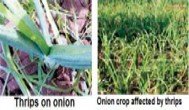 Both adult and larval thrips feed within the mesophyll layer using a punch-and-suck motion.
Lifeline + Traps + Meta + BT
Mite
Both adult and larval thrips feed within the mesophyll layer using a punch-and-suck motion.
Lifeline + Traps + Meta + BT
Mite
 Adults and nymphs feed primarily on the undersides of the leaves. The upper surface of the leaves becomes stippled with little dots that are the feeding punctures.
Lifeline + Traps + Meta + BT
Cutworm
Adults and nymphs feed primarily on the undersides of the leaves. The upper surface of the leaves becomes stippled with little dots that are the feeding punctures.
Lifeline + Traps + Meta + BT
Cutworm
 Missing, cut, or wilted plants Holes or cavities in leaves, fruits, or roots.
BT + Meta
Downy Mildew
Missing, cut, or wilted plants Holes or cavities in leaves, fruits, or roots.
BT + Meta
Downy Mildew
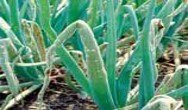 Leaves turn pale green. On leaves, cottony white mycelial growth develops and appears white. Gradually the leaves turn pale yellow to dark brown and dry up.
Life-line + Indofa + BT + Bacillus
Fusarium Wilt
Leaves turn pale green. On leaves, cottony white mycelial growth develops and appears white. Gradually the leaves turn pale yellow to dark brown and dry up.
Life-line + Indofa + BT + Bacillus
Fusarium Wilt
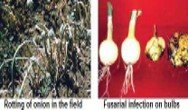 Initially yellowing of leaves and stunted growth of the plant is observed, which later on dry from tip to downwards.
Indofa + BT + Lifeline
Damping Off
Initially yellowing of leaves and stunted growth of the plant is observed, which later on dry from tip to downwards.
Indofa + BT + Lifeline
Damping Off
 Pre-emergence damping-off:This results in seed and seedling rot before they emerge out of the soil.Post-emergence damping-off:The pathogen attacks the collar region of seedlings on the surface of the soil.
Indofa + Bacillus
Purple Blotch
Pre-emergence damping-off:This results in seed and seedling rot before they emerge out of the soil.Post-emergence damping-off:The pathogen attacks the collar region of seedlings on the surface of the soil.
Indofa + Bacillus
Purple Blotch
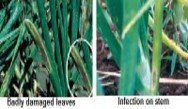 The symptoms occur on leaves and flower stalks as small, sunken, whitish flecks with purple-colored centers.
Indofa + Bacillus
Leaf Blight
The symptoms occur on leaves and flower stalks as small, sunken, whitish flecks with purple-colored centers.
Indofa + Bacillus
Leaf Blight
 Infection occurs on radial leaves of transplanted seedlings at the 3- 4 leaf stage during late March and early April.
Indofa + Bacillus
Anthracnose
Infection occurs on radial leaves of transplanted seedlings at the 3- 4 leaf stage during late March and early April.
Indofa + Bacillus
Anthracnose
 The symptoms appear initially on the leaves as water-soaked pale yellow spots, which spread lengthwise covering the entire leaf blade.
Indofa
Aphid
The symptoms appear initially on the leaves as water-soaked pale yellow spots, which spread lengthwise covering the entire leaf blade.
Indofa
Aphid
 Misshaped, curled, or yellow onion leaves. Sticky substance on the onion stem, Galls on the roots or leaves, and Small bugs on the opposite part of the leaf.
Lifeline + Traps + Meta + BT
PRECAUTIONS: -
Biofertilizer is not a chemical fertilizer hence do not mix with agrochemicals.
Do not expose to direct sunlight or heat.
Use Bio-fertilizer before or after 3-4 days of use of chemical fertilizer.
Please, clean the sprayer before the use of Bio-fertilizer or bio-pesticide.
Misshaped, curled, or yellow onion leaves. Sticky substance on the onion stem, Galls on the roots or leaves, and Small bugs on the opposite part of the leaf.
Lifeline + Traps + Meta + BT
PRECAUTIONS: -
Biofertilizer is not a chemical fertilizer hence do not mix with agrochemicals.
Do not expose to direct sunlight or heat.
Use Bio-fertilizer before or after 3-4 days of use of chemical fertilizer.
Please, clean the sprayer before the use of Bio-fertilizer or bio-pesticide.
NUTRITION DEFICIENCY
NUTRIENT
IDENTIFICATION
SYMPTOMS
SUGGESTED PRODUCT
Nitrogen
 Leaves become yellowish green erect and upright curled, wilted, and dwarf. At maturity tissue above the bulbs becomes soft.
Azoss Caps/
Azoto Caps
Phosphorus
Leaves become yellowish green erect and upright curled, wilted, and dwarf. At maturity tissue above the bulbs becomes soft.
Azoss Caps/
Azoto Caps
Phosphorus
 Slow growth, maturity blazed. Leaf color becomes light green and bulbs have few dried outer peals. Tip burn in older leaves.
PSB Plus
Potash
Slow growth, maturity blazed. Leaf color becomes light green and bulbs have few dried outer peals. Tip burn in older leaves.
PSB Plus
Potash
 symptoms only develop on young leaves in the case of extreme deficiency. Tip burn symptoms, leaves become dark green and erect. Bolting promoted.
Potash Grow
Iron
symptoms only develop on young leaves in the case of extreme deficiency. Tip burn symptoms, leaves become dark green and erect. Bolting promoted.
Potash Grow
Iron
 Complete yellowing of young leaves. Because iron has low mobility, iron deficiency symptoms appear first on the youngest leaves.
ALP
Manganese
Complete yellowing of young leaves. Because iron has low mobility, iron deficiency symptoms appear first on the youngest leaves.
ALP
Manganese
 Leaves show tip burn, light colored and curling. Growth restricted. Bulbing delayed with thick necks.
ALP
Zinc
Leaves show tip burn, light colored and curling. Growth restricted. Bulbing delayed with thick necks.
ALP
Zinc
 Growth restricted. The leaves show interveinal necrosis.
Zinc Grow Caps
Sulphur
Growth restricted. The leaves show interveinal necrosis.
Zinc Grow Caps
Sulphur
 The leaves show general overall chlorosis. The yellowing is much more uniform over the entire plant including young leaves.
Sulphur Caps
The leaves show general overall chlorosis. The yellowing is much more uniform over the entire plant including young leaves.
Sulphur Caps
 Leaves become yellowish green erect and upright curled, wilted, and dwarf. At maturity tissue above the bulbs becomes soft.
Azoss Caps/
Azoto Caps
Phosphorus
Leaves become yellowish green erect and upright curled, wilted, and dwarf. At maturity tissue above the bulbs becomes soft.
Azoss Caps/
Azoto Caps
Phosphorus
 Slow growth, maturity blazed. Leaf color becomes light green and bulbs have few dried outer peals. Tip burn in older leaves.
PSB Plus
Potash
Slow growth, maturity blazed. Leaf color becomes light green and bulbs have few dried outer peals. Tip burn in older leaves.
PSB Plus
Potash
 symptoms only develop on young leaves in the case of extreme deficiency. Tip burn symptoms, leaves become dark green and erect. Bolting promoted.
Potash Grow
Iron
symptoms only develop on young leaves in the case of extreme deficiency. Tip burn symptoms, leaves become dark green and erect. Bolting promoted.
Potash Grow
Iron
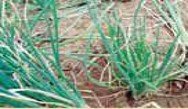 Complete yellowing of young leaves. Because iron has low mobility, iron deficiency symptoms appear first on the youngest leaves.
ALP
Manganese
Complete yellowing of young leaves. Because iron has low mobility, iron deficiency symptoms appear first on the youngest leaves.
ALP
Manganese
 Leaves show tip burn, light colored and curling. Growth restricted. Bulbing delayed with thick necks.
ALP
Zinc
Leaves show tip burn, light colored and curling. Growth restricted. Bulbing delayed with thick necks.
ALP
Zinc
 Growth restricted. The leaves show interveinal necrosis.
Zinc Grow Caps
Sulphur
Growth restricted. The leaves show interveinal necrosis.
Zinc Grow Caps
Sulphur
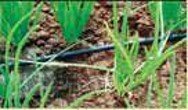 The leaves show general overall chlorosis. The yellowing is much more uniform over the entire plant including young leaves.
Sulphur Caps
The leaves show general overall chlorosis. The yellowing is much more uniform over the entire plant including young leaves.
Sulphur Caps


